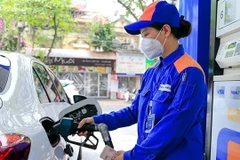
Hanoi (VNA) - Hanoi’s urban railway system is revolutionizing the city’s transportation network, earning public trust and attracting growing ridership.
The capital city of Hanoi has introduced two metro lines, Cat Linh-Ha Dong and the elevated section of Nhon-Hanoi Station, which have drawn significant public use. Experts consider urban railways to be high-capacity public transportation systems and the backbone of the capital city’s transportation network.
In recent years, new bus fleets, electric buses, and urban railways have transformed Hanoi’s public transportation system, contributing to the development of a Green urban environment.

Pham Thanh An, a long-time Hanoi resident from Nam Tu Liem district, shared: “New buses reduce air pollution, while electric buses are smooth and eco-friendly. Urban railways, with air conditioning, quick travel times, and no traffic delays, have changed commuting habits and fostered a more modern traffic culture.”
The Nhon-Hanoi Station metro line served over 256,000 passengers within its first four days of operation, setting a record of 100,515 passengers on August 11, 2024.
Meanwhile, the Cat Linh-Ha Dong line, which began operations on November 6, 2021, recorded 55,980 passengers on September 2, 2023, Vietnam’s National Day.

Vu Hong Truong, Chairman and CEO of Hanoi Metro, once described the Cat Linh-Ha Dong line as a “lonely star” due to its lack of integration with other lines.
He emphasized that urban railways not only alleviate congestion and pollution but also restructure urban spaces, drive socio-economic growth, and support Hanoi’s vision of becoming a Green, modern, and livable city.

Nguyen Cao Minh, head of the Hanoi Urban Railway Management Board (MRB), outlined plans for a network of 15 metro lines spanning 397.8 km by 2035 and 196.2 km by 2045.
Minh underscored that urban railway development is crucial for sustainable growth, environmental protection, and regional connectivity.
He suggested that a mechanism be established to allow Hanoi to independently mobilize funding for urban railway construction. This would include collecting taxes and fees, auctioning land use rights, and commercial exploitation rights in planned TOD (transit-oriented development) areas.

Deputy Chairman of the Hanoi People's Committee Duong Duc Tuan stated that the city has proposed that the government implement special, breakthrough policies to decentralize authority. This would enable the city to focus resources, streamline procedures, balance funding, and ensure synchronization of technical infrastructure, including locomotives, carriages, and tracks, with a particular emphasis on connecting systems and inter-regional links between provinces and cities.
With trains on the Cat Linh-Ha Dong and Nhon-Hanoi Station lines running at full speed, they carry the hopes of residents for a modern and comprehensive urban railway network, reshaping Hanoi’s infrastructure and enhancing its urban landscape every day./.





























